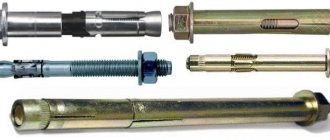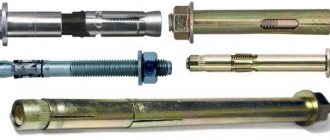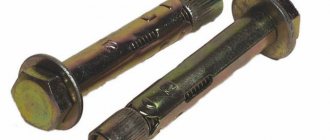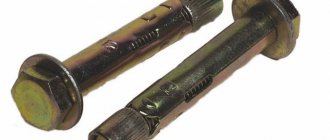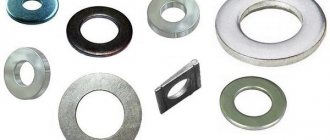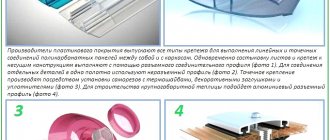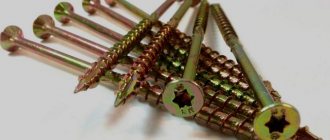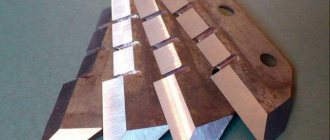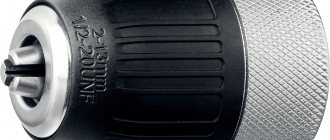Anchors for concrete are special fasteners necessary for reliable fixation of various objects and elements on concrete structures. Fastening elements are used where the strength of the walls does not allow the use of screws or nails. Usually, equipment and furniture are attached to walls in this way; they are also relevant for installing doors and windows.
Externally, a concrete anchor looks like a bolt. It is made of galvanized or stainless steel in the shape of a cylinder with a cone-shaped extension at the end of the fastening. The spacer part opens into the concrete after installation and ensures maximum density between the elements and guarantees reliability.
The concrete anchor is installed in a hole of the required size. The high holding capacity of the anchor is ensured by the force of friction, gluing using a special composition, and the interaction of the thrust element with the inner walls of the hole.
Working principle and application
Concrete is a porous material with a heterogeneous structure. And in the places of fastening, various forces appear - twisting, bending, shearing, shearing, compression, tearing. The concrete anchor takes over them, distributing them together with the supporting structure.
Basic principles of operation of concrete anchors:
- At the moment of interaction between the base material and the anchor, a frictional force appears - the expansion is carried out with dowels and metal collets.
- When, at the depth of anchoring, the material provides resistance to fracture or crushing - due to collet bushings on the fasteners, the curved shape of the rod, and expansion.
- Loads at the point of contact between the base and the rod are compensated by tangential stresses during embedding or gluing - this is how smooth, adhesive anchors work.
Anchors for concrete can be of different designs, types, sizes. They are made from special steel according to GOST and coated with a layer of anti-corrosion agent. The rod can be 6-20 millimeters in diameter and up to 220 millimeters long.
Any anchor includes the following parts:
- The bolt itself
- Cone with a layer of thread inside
- Bushing with special cutouts
Anchors perform a constructive or load-bearing function. The load-bearing function is implemented in cases of connecting floor slabs, beams, columns, balcony consoles, landings and flights, finishing and wall panels, engineering equipment, communications, hoods, ceiling lamps, etc. Anchors are also used for installing joists on concrete or hollow-core floors. They are used to attach electrical equipment and hanging furniture to walls.
Structural fasteners are used to counteract the displacement of parts of the assembly if their stability is guaranteed by their own weight; anchors are also relevant when straightening in construction.
What is an anchor: general concept
The word “anchor” means a fastener used for fixing various objects on structures made of solid solid materials - concrete, building bricks, natural stone, etc. To install such fasteners, you should prepare a hole with the appropriate dimensions in which the anchor-type bolt will be placed . The high holding capacity of a bolt placed in such a hole can be ensured by:
- friction forces (expansion-type anchor products);
- adhesive abilities of a special composition (chemical anchor elements);
- a special thrust element interacting with the inner walls of the hole.
Any anchor has a spacer part
The most popular anchor is a fastening element, which, due to its design features, is wedged inside the hole, thereby ensuring high reliability of the connection being created. The surface of such bolts, made of carbon steel, is coated with a zinc composition, which eliminates the risk of the occurrence and development of corrosion.
Types and types of anchors and methods of their fastening
Anchors for concrete can be very different, using one or more acting forces - emphasis, intermolecular bonding during the gluing process, friction, bending, compression, etc. Depending on their purpose, concrete anchors can be frame, ceiling, foundation or universal. In shape - curved and straight, with a prefabricated or solid structure.
The surface of the anchor can be corrugated or smooth. There are different types of fasteners depending on the contact area - those that are used for porous materials and those that are used for dense ones. According to the installation method, anchor fasteners for concrete may involve through connection, gluing, hammering, screwing, etc.
The material from which the hardware is made is of great importance. If it is steel of strength class 6.8 or higher, coated with an anti-corrosion coating, then the fastening will be as strong as possible. But brass will not withstand serious vertical loads.
Spacers
Expansion anchors for concrete are usually used with nuts, here the working force is the friction force. They are a small threaded pin with a cone-shaped tip and a sleeve. When the fastener is screwed into the base, it wedges and firmly holds the fastener in the monolith.
The main advantages of such anchors: the ability to perform through installation, lightness and simplicity of installation, excellent load-bearing capacity. Wedge anchors are chosen mainly for dense concrete; they sink deeply and cannot be used a second time.
If the anchor bolt has a hook (bracket) installed at the end instead of a nut, the mount is suitable for attachments. Wedge anchors come in sleeve and sleeve types. Such a bolt looks like a bushing with special cutouts; at the end it can be made with a stud with a conical extension or a wedging nut. Used for medium and high density substrates. A small contact area, even with a minimum diameter of the product, makes it possible to withstand significant loads.
The anchor bolt with nut can be electrogalvanized (KA), hot-dip galvanized (HAK), and also have acid-resistant properties (KAN). This also includes screw anchors made of stainless steel (RAR).
Drivers
Drive-in concrete anchors are chosen for dense concrete. These are short bolts with an internal cone and metric threads. The fastener wedges the base when a pin or bolt is screwed into the concrete; the fastener does not protrude onto the surface.
Installing anchors in concrete using this type of bolts is relevant when installing ducts, ceiling air ducts, and installing engineering equipment. Before hammering an anchor into a concrete wall, drill a corresponding hole. Then they hammer in the hardware, use a punch-rim to wedge it, and screw in a threaded rod of the required length.
This type of anchor includes a dowel-nail and a ceiling anchor. It is convenient to attach suspensions, slats, and Armstrong ceilings to them. Fasteners are often used as fireproof or vandal-proof, since the bolt is non-removable.
Frame
Used for fastening door and window frames. The sleeve is made with a cut along its length; a small wedging nut, during the tightening process, presses the structure well against the opening, bringing it to the desired position. To protect against displacement and rotation around its own axis, there are stops at the top of the sleeve.
Self-tapping screws for concrete
Here, the reliability of the connection is ensured by threads running along the entire length of the bolt. During the process of screwing into the concrete base, a powerful resistance to tearing or shearing of the product is created. Therefore, when using this type of fastener, a very high load-bearing capacity is observed. The self-tapping screw can easily take up to 100 kilograms of load, is very reliable in operation and easy to install.
Expanding
In everyday life, this type of anchor is called a “butterfly” (aka Molly bolt). Used for mounting cornices, shelves, lamps, paintings and other elements in hollow structures with low load-bearing capacity. The collet on the screw or bolt is made in the form of a wedging skirt, which, in the process of screwing the rod into the base, rests against the inside of the base cavity. On the outside of the collet, special spikes are embedded in the concrete, which prevent the bolt from moving or turning during installation.
Chemical anchor
The anchor bolt for concrete is made in the format of a semi-liquid mass that quickly hardens. It is with this mass that the bolt or pin is glued into the monolith. Thanks to the composition, it is possible to ensure a reliable connection between the base and the bolt without local or point stresses, but with a uniform distribution of the load along the entire length of the fastener.
Chemical anchors for concrete do not provoke internal stress at all, significantly reducing the risk of destruction and deformation.
Features of installation of anchors for concrete
The reliability of fastening obtained using an anchor bolt is influenced by a number of factors:
- the quality of the material in which the anchor is installed;
- the type and dimensions of the fastening element, which must be selected in accordance with the loads perceived by such a product;
- correct preparation of the site for placing fasteners and compliance with the technology for its installation;
- strength characteristics of the anchor itself.
Sequence of installation operations (click to enlarge)
Installation of anchor-type bolts can be carried out in various structures, the material of which must be of sufficiently high strength. These include, in particular:
- concrete foundations;
- walls and partitions made of concrete and brick;
- floor slabs, which are usually made of concrete.
Mechanical anchor installation diagrams
Objects and structural elements that are fastened with such bolts are usually:
- beams made of rolled metal of various types;
- elements of suspended ceiling structures;
- lamps and chandeliers;
- wooden beams used for installation of floor and ceiling coverings;
- elements of staircase structures;
- load-bearing structures with large weight and dimensions.
Load calculation depending on anchor parameters
As mentioned above, fixing an anchor-type bolt inside a pre-prepared hole can be achieved in two main ways:
- by wedging the spacer sleeve inside the hole;
- due to a special adhesive composition that binds the bolt and the inner walls of the hole (chemical anchor).
There are requirements for holes in the fastened part, which should not exceed the values specified in the table. Large gaps can be filled with mortar
Dimensions and characteristics of anchor bolts
Before deciding which anchor is best for concrete in performing specific tasks, it is necessary to consider not only the variety of designs, but also the sizes, because fasteners can be of different lengths and diameters.
Classification of anchors by size:
- Small – cross-section up to 8 millimeters/length up to 55
- Medium anchors – up to 12/120 millimeters
- Large - with maximum dimensions of diameter 24 and length 220 millimeters
An anchor bolt for concrete can have different sizes: the characteristics are determined by three indicators. So, if we decipher the marking M8 10/60-115, then it will be: the diameter of the thread of the anchor M8, the outer diameter 10 (this is the diameter with which the hole for fastening is drilled, this is the diameter of the drill), the length of the anchor is 115 millimeters, the approximate thickness of the element that it is planned to strengthen - 60 millimeters.
All technical characteristics of anchors are indicated in the table, these can be weight, maximum torque and permissible bending moment, minimum pull-out force, optimal loads, distance between axes and to the edge, etc. In accordance with all these parameters, suitable products are selected and high-quality fastening to concrete with anchors is performed.
Driven anchor
The design of the driven anchor includes the following components:
- metal sleeve with slots;
- spacer element. It is located inside another bushing.
The internal thread is made in the shape of a cone. Technological slots are necessary to form petals, which, when driving the spacer component into the anchor, act as spacers. They are the ones that hold this fastener in the hole during operation.
Technical characteristics of the most popular nomenclature items of the driven anchor are presented in the table. The unit of measurement is millimeters.
| Size | M20/25×80 | M16/20×65 | M12/16×50 | M10/12×40 | M8/10×30 | M6/8×25 |
| Anchor length | 80,0 | 65,0 | 50,0 | 40,0 | 30,0 | 25,0 |
| Screw-in depth | 20…33 | 16…25 | 12…19 | 10…15 | 8…13 | 6…11 |
| Hole diameter | 25 | 20 | 16 | 12 | 10 | 8 |
| Thread length | 33 | 25 | 19 | 15 | 13 | 11 |
| Metric thread | M20 | M16 | M12 | M10 | M8 | M6 |
The anchoring depth is equal to the length of the product.
The resistance characteristics of the driven anchor are listed below.
| Standard size | Concrete B20 without cracks | |
| Design force | ||
| shear, kN | Breakout, kN | |
| M20 | 33,6 | 24,0 |
| M16 | 21,1 | 7,6 |
| M12 | 12,3 | 9,9 |
| M10 | 6,9 | 7,1 |
| M8 | 5,5 | 4,6 |
| M6 | 4,1 | 3,0 |
Installation of this product is carried out using the pre-installation method.
Installation instructions
Before fixing the anchor bolt in concrete, you need to prepare the tools. To complete the work you will need: a wrench, a construction vacuum cleaner, a drill with a hammer function or a rotary hammer, a concrete drill, a hammer.
Drilling
First, the base is carefully marked for future drilling locations. Here you need to do everything as accurately as possible, since after installation it is not possible to remove the anchor bolt from the concrete - the fixation is very strong. Next, according to the markings, holes of the required length are drilled in the concrete (measured along the spacer part of the bolt), installing a limiter on the drill.
The distance from the edge of the wall should be at least 2.5 times the depth of the hole. Next, the holes need to be cleaned with a vacuum cleaner, compressed air from a can, or a rubber blower. If you cannot remove the crumbs without leaving a residue, you can deepen the hole by 1-2 centimeters.
Installation of anchor with nut
The spacer part of the bolt is inserted into the base and driven in with a hammer until it is completely immersed in the concrete (so that the edges are flush with the wall). Then a threaded rod or bolt is inserted, the nut is tightened, twisting as much as necessary so that further turning is impossible.
It is advisable to learn in advance how to use a specific type of fastener. Manufacturers may set the maximum torque, in which case a torque wrench will be needed. Tightening all the way when working with some substrates (aerated concrete, foam concrete) can cause deformation and destruction of the material.
Chemical anchor installation
To install chemical fasteners in concrete, you need a slightly modified set of tools: you will need a hammer drill, a wrench, a construction vacuum cleaner, as well as threaded rods, glue or capsules, and a mounting gun. For a large number of fasteners, glue is chosen; the choice of capsules (ampoules) is relevant where small volumes of work are planned.
First, mark the base, drill and clean the holes. Before pouring the adhesive solution into the concrete, it is advisable to screw in a mesh sleeve, thanks to which the chemical substance will be retained inside. Then you need to fill the holes 2/3 with glue (using a mounting gun) or install the capsules, insert the pin, gradually screwing it in to evenly distribute the adhesive. Now you need to wait until the glue dries and only then tighten the nut with a wrench.
Wedge anchor
It is a special wedge nut installed inside the hole, with a sleeve installed on top. When the bolt is tightened, the nut, trying to come out, wedges the sleeve and is firmly held inside the hole.
This design is a bushing with a conical hole inside and a thread. When screwing in the anchor, the sleeve wedges into the hole and is thus fixed.
Expandable butterfly anchor. The main feature is that it can be installed in through holes, as well as in the case of thin-walled bases. The principle of operation is based on the deformation of the middle part and the opening of the petals when screwing in the anchor.
Expansion anchors. This is the most common type and does not require particularly careful adherence to the hole dimensions. The principle of operation is based on the expansion of the bushing when a pin with a cone-shaped or spherical thickening at the end is pulled out of it during the process of screwing a nut onto it and pulling it out.
So, we have indicated the main types of anchors used in practice. In some specific situations, special fasteners are required; according to the underlying principles of operation, they are similar to those discussed, but they have design features, and therefore two of their varieties are presented below, as an example.
Pros and cons of use
The main advantages of using anchor bolts for concrete are maximum reliability and strength of structures. Anchors can withstand enormous loads and guarantee high-quality fastening in concrete with characteristics that cannot be achieved using other types of fasteners.
The main advantages of concrete anchors:
- Resistance to deformation and corrosion
- Lightness, simplicity and high speed of installation
- Resistance to dynamic and static loads of various types
- Large selection of anchors by length, diameter, type of fastening, load, function, shape, material, etc.
Selecting an anchor bolt for a particular task is not difficult. There are no obvious disadvantages to this type of fastener. Unless you need to remember some features: the importance of accurate markings, the correct selection of drills for concrete and determining the depth of the hole, the need to use a certain set of tools.
Main characteristics of anchors
The anchor is a steel rod, ranging in size from 45 mm to 200 mm. A characteristic design feature is provided by a sleeve with longitudinal slots and a nut.
In the product name, the first number indicates the diameter of the suitable hole, the second – the length of the fastener itself, and the third – the thread size.
When choosing a reliable connection, you need to pay attention to the following:
- model and location of the structure;
- terms of Use;
- fastening type;
- options;
- results of load calculation (exceeding 25% of the load specified in GOST is not permissible).
For foam concrete
Foam concrete is used today in many areas due to its poor flammability, low density, excellent thermal insulation properties and resistance to temperature changes of the material. The structure of the foam block consists of a large number of frozen bubbles. Screws, dowels, and self-tapping screws can be used to fasten the material. The highest level of reliability of foam block fastening is provided by plastic and chemical anchors.
Principle of operation
The anchor bolt maintains a strong holding moment inside concrete or masonry substrates thanks to three basic operating principles:
- friction - due to the presence of a bursting force that is created when a plastic dowel or metal collet is pushed apart;
- the persistent load that is created in the depth of the anchorage;
- gluing or embedding - achieved by using adhesive anchors or embedded parts.
There are types of anchor bolts that combine these principles.
How to install an anchor bolt in concrete
The whole process is quite simple, the main thing is to take the measurements correctly and implement everything as accurately as possible. But there are several nuances that need to be taken into account.
Practical tips for installing anchors in concrete:
- The strength of the fastener is influenced not only by the anchor, but also by the quality of the base material (concrete in this case), proper preparation for installation, taking into account the material of the attached structure and the design of the bolt itself.
- If a layer of finish is applied to the wall, the hole must be deeper because the finish is usually less durable than concrete.
- It is advisable to take a drill 0.5 millimeters thinner than the diameter of the future hole.
- When working with a hammer drill, it is best to use a tip made of a special carbide material.
- Read the instructions carefully - the packaging with anchors should indicate the permissible force and the maximum number of revolutions.
- When screwing the anchor into foam concrete or aerated concrete, under no circumstances twist it all the way, as the material may collapse.
Eternal fastener: concrete dowel
A dowel is a spacer element made of polypropylene or nylon, which is similar in function and performance to an anchor. It cannot be used independently; it is fixed in concrete with special nails or self-tapping screws. To strengthen the fixation, it is often performed with spikes or antennae.
This type of fastening is used where there are not too large loads on the concrete - fastening shelves, TV hooks, lighting fixtures. The dowels are driven into the concrete wall with a hammer, and the screws are screwed in with a screwdriver or screwdriver. You will also need a regular hammer to drive in nails.
You can also find dowel nails designed for use with a mechanical gun. The fasteners in concrete are made of metal; in appearance, they somewhat resemble a bullet. Relevant where you need to hang a large number of small items.
Concrete dowel: fast but durable
Pins are concrete screws that are most often used to install fasteners near the edges of a concrete wall. The fastener does not require additional fixation; it is screwed into the hole, where a little epoxy glue is first poured. There is no need to drill holes - the dowel can be screwed directly into the concrete wall. If you still need to make a hole in concrete, then it is better to choose a drill (a hammer drill can damage the wall).
They screw it in with a screwdriver - and after that it is no longer possible to unscrew the dowel back. Therefore, preliminary marking must be done especially carefully.
Hairpin anchor
The structural elements of this fastener are a threaded rod and a spacer type coupling. The delivery set of the stud anchor also includes a nut and a flat washer with the corresponding diameters.
The installation procedure includes the following steps:
- drilling a hole in a concrete base;
- removing formed particles from it;
- driving the anchor pin into the hole prepared for installation.
This fastener is fixed in the hole while tightening the nut while simultaneously holding the suspended structure. And here you need to tighten the nut using a torque wrench with the force specified by the manufacturer.
The modern metallurgical industry produces stud anchors in a relatively wide range of metric thread diameters - from M6 to M24. The maximum length values of this hardware are also impressive - min 40 mm; max 300 mm. This range of dimensional characteristics makes it possible to fasten elements whose thickness is a minimum of 5 and a maximum of 130 millimeters.
Typical loads in C20/C25 concrete are presented in tabular form
| Diameter | Load, kN | |
| For cutting | To break out | |
| 6,0 | 7,20 | 7,80 |
| 8,0 | 13,30 | 12,50 |
| 10,0 | 19,20 | 20,30 |
| 12,0 | 27,20 | 24.20 |
| 16,0 | 50,10 | 38,80 |
| 20,0 | 74,0 | 40,0 |
| 24,0 | 98,10 | 56,0 |
The installation method of the anchor stud is through installation.
Anchoring of building structures
Anchor elements ensure the transfer of the load from attached objects to the anchor base, which can be a load-bearing or non-load-bearing building structure.
A wide range of natural and industrial materials can be secured with anchor bolts. The load on the base can be static or dynamic.
The environment in which anchor elements are placed also has a fundamental influence on their selection in terms of influencing the material of the anchors, whether they are embedded in the structure or located in an open space, air gap.
Attaching objects can be done in two ways.
- Having secured the anchor bolts in advance;
- Additional fastening of anchors.
Anchoring can be done in bricks, concrete, metals, plastics and wood. For these purposes, materials can be divided into groups according to the cubic capacity of the material:
- With low cubic strength below 10 MPa. Such materials include solid brick masonry, hollow brick masonry, plasterboard, foam concrete;
- With cubic strength from 10 to 50 MPa. These materials can be used to remove and install anchors with high load-bearing capacity. This group includes high-strength brickwork and concrete;
- Cubic strength more than 50 MPa. Installation of anchor bolts in such structures is impossible.
Fastening to plastic and wood is carried out by a simple technology of hammering various nails manually or pneumatically. Another way is to drill out the screws.
Anchor selection
When choosing a bolt, they are guided by special tables with recommended data on the calculated, as well as the maximum load on one specific fastener. The table indicates:
- weight of the fastening element;
- pull-out force – to a minimum;
- bending - to maximum;
- torque to maximum.
When choosing an anchor bolt, you must take into account the weight of the structure being mounted. The heavier it is, the larger the anchor should be. The thickness of the base to which the anchor will be attached must also be taken into account. Otherwise, due to a mismatch in size, the bolt may pierce through the base.
It is very important to be guided by the tabular data for calculating anchor bolts, since they are recommended based on tests and comply with GOST.
Anchor bolt: what types of failures occur?
Because bolts are subject to heavy loads, there are several consequences caused by improper installation or choice of fastener type. Each anchor bolt can withstand certain loads. You can get information about this by deciphering the markings. According to GOST, a list of breakdowns that can occur in a fastening connection is determined:
- tearing out the bolt from the fixing surface. There are superficial or partial tearing out;
- tearing out the main platform. Due to the impact of heavy loads on the base itself, complete failure may occur;
- bolt bending. Most often happens during installation;
- melting. When exposed to unacceptable high temperatures, the bolts may melt.
GOST standards specify the requirements for storage, operation, installation, and production of anchor bolts. They have their own markings. Study the properties of the bolts before installation to prevent damage and ensure a durable connection. We must not forget about calculating the permissible load and the technical characteristics of the bolts.
Application
Before installing the dowel with the nut, you must first make a hole in the concrete base, the size of which should be such that the sleeve fits in there with little force. To form a hole, it is recommended to use a hammer drill or a drill with special attachments. Afterwards, you need to clear the hole of debris and insert a bolt there. It is important to tighten the nut until the spacer properly secures the fastening system. Then the nut is twisted, leaving the threaded end free, so that the object to be fixed can then be installed on it. Finally, you need to put on the washer, and then screw on the nut.
Chemical
They are a screw for concrete, for reliable fixation of which a special hardener is used. Before installing the dowel, a hole is pre-drilled into which the glue ampoule is inserted. Next, the pin is screwed in, after which the elements are left for the time specified in the instructions to dry completely. Loading the fastening system is contraindicated until the adhesive has completely dried. It is important to remember that the drying time depends on many factors, including weather conditions and ambient temperature.
Chemical dowels are often used if there is a need to securely attach wood to concrete, for example, joists, on which floor boards will then lie. For plywood under laminate, in addition to dowels, it is recommended to additionally use special glue. Installation of insulation and laminate is carried out only after the adhesive layer has completely dried.
Drive-in anchors and brass collets
These are two externally similar metal anchors with internal threads, the fixation of which in the building base is carried out as a result of impact. Both types require high strength of the base material and precision hole diameters. Most often they are used for ceiling mounts when laying pipelines, ventilation systems, and cable ducts.
The brass collet has a conical hole and cuts that form spacer elements that diverge to the sides when the fastening bolt is screwed in.
The steel hammer anchor is distinguished by the presence of a conical wedge inside. During installation, the wedge is struck using a special tool, as a result of which it moves to the end of the sleeve and pushes its cut part apart. Only after this can the bolt be screwed into it.
Due to the design and material features, a steel driven anchor can withstand higher loads than a brass collet anchor. Sormat anchors and collets
:
- + — galvanized (structural steel)
- LAH - stainless (acid-resistant steel A4)
- MSA - brass
